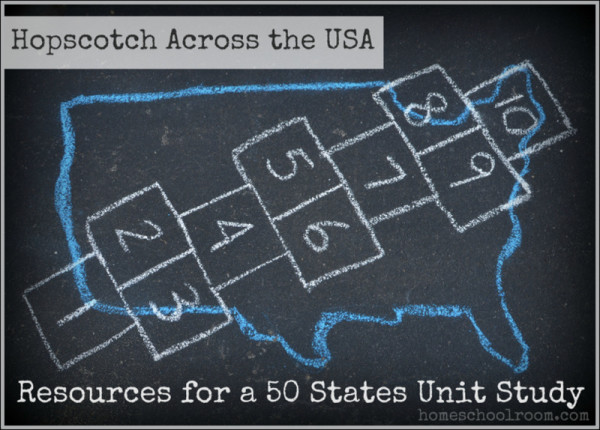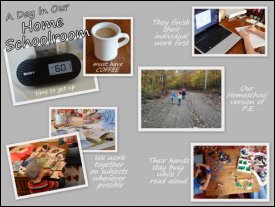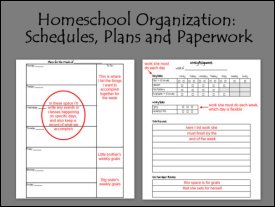50 States Unit Study: Nature Study

Welcome to day 8 of Hopscotching Across the USA! I’m sharing resources for a 50 States Unit Study and today I’m talking about nature study.
Nature study is a regular part of our school schedule as Charlotte Mason-inspired homeschoolers. Though nature study usually involves direct observation of items in your local environment, in our 50 states study it was about studying nature in other parts of our country. Being in the far northeast is was fascinating to learn about the environment and living things in different states.
America’s physical diversity ranges from mountain to prairie, deserts to tundra. Some areas have long cold winters while others stay humid and tropical. If you have a U.S. Atlas you can introduce your children to this diversity with the maps that show physical or environmental features. Education Place’s free printable maps for the climate (average temperature and annual precipitation) and physical features (major mountains and rivers) are great for adding to their binder to refer to as you study each state.
*This post contains affiliate links.
Animals of America
We didn’t focus on remembering which 7 states chose the cardinal as their state bird, but we did learn about some of the different animals that call the United States home. When there was a new-to-us animal (like the bison of the prairie or the alligators of the Southeast or the armadillo of Texas) that we wanted to learn about two sites were valuable, easy resources:
- For birds you can’t beat Cornell’s All About Birds website. Search for any bird in the United States and you can find out all about it’s lifestyle, where it lives, and enjoy images, sound clips, and often videos.
- For animals we can usually find it on National Geographic Kids. You can find general information about the animal, a distribution map, along with photos and often sound clips or videos.
United Tweets of America is a comical educational book worth adding to your bookshelf. The story line is that the birds from each state are competing in a pageant. You won’t find the standard basic statistics about each state, but it is filled with interesting information and anecdotes.
Plants of America
When it comes to plants I wasn’t attempting to teach my children about all the plants in our country. The atlas has photos of the state flowers, and 50states.com has photos and information for the state flowers and trees. There were a few interesting stories and books about some famous trees of the 50 States:
- The Palmetto Tree of South Carolina (it’s the state tree, part of the nickname, and is on the flag) has an interesting story: during the Revolutionary War a fort built from the Palmetto absorbed cannon shot due to its spongy wood, helping protect Charleston Harbor from the British.
- Incredibly strong Live Oak was used with White Oak to build the U.S.S. Constitution, and earned her the nickname “Old Ironsides.”
- These three books about trees are some of our favorites–they aren’t dry science books about identifying trees, but highlight the importance of trees in our country and the history that trees live through with us:
- Arbor Day Square is a book about trees on the wide open prairie–and the beginning of Arbor Day.
- The Tree That Would Not Die tells the story of the 500 year old Treaty Oak tree in Texas, (a southern live oak like those used in Old Ironsides) relating a lot of history along the way. I’ll admit getting teary reading the part about the poisoning of the tree.
- Tree in the Trail by Holling C. Holling is about a cottonwood tree on the great plains, relating the history of the native people, white settlers, and the Santa Fe Trail.
Natural hazards
The topic of natural hazards fascinated my children, especially my son, probably because in Maine our only natural hazards are blizzards and ice storms. Sometimes we get the tail end of a hurricane but usually with very little impact. Not that I’m complaining, but it was a subject that many other Americans have a greater working knowledge of due to suffering the effects closer to home.
- Earthquakes: we read two books about Earthquakes: Earthquakes (Let’s Read and Find Out Science) by Franklyn M. Branley and Earthquakes by Seymour Simon.
- Volcanoes: National Geographic Kids: Volcanoes! shows the ring of fire and features created by volcanoes like Crater Lake in Oregon, Hawaii, and the geysers of Yellowstone. We learned about the 1980 eruption of Mt. St. Helens in this fascinating and educational YouTube video from geologists who had been watching the volcano for two months, and this video from the Forest Service is newer and gives an update on the area now.
- Tornadoes: the power of tornadoes was clear in a Nova show: Hunt for the Supertwister, which is available to watch from PBS on YouTube.
Come back tomorrow for a critical part of a 50 states study: learning about the people of the United States. Subscribe via email or RSS so you don’t miss a post!
Here are the topics from this series:
Day 1: Introduction to the 50 States Unit Study
Day 2: Learning About the States
Day 3: Getting to Know Your Geography
Day 4: Games to Play
Day 5: Recording Your Journey
Day 6: Famous Places in the USA
Day 7: Natural Attractions
Day 8: Nature Study
Day 9: The People of America
Day 10: Food from the 50 States
I’m teaming up with over 25 other iHomeschool Network bloggers. Hop over to iHN for ideas from veteran homeschooling moms on topics ranging from Teaching with Legos to Project Based Learning.

 Hi, I'm Heidi and I homeschool my two sweet kids. I want them to know that learning is an exciting lifelong adventure! We love great books, unit studies, notebooking, lapbooking, and hands-on learning.
Hi, I'm Heidi and I homeschool my two sweet kids. I want them to know that learning is an exciting lifelong adventure! We love great books, unit studies, notebooking, lapbooking, and hands-on learning.



